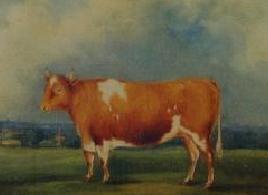The Guernsey cow is a truely unique and prized member of the cattle family. It has a world wide reputation and milk from the breed is used in many countries to blend with weaker less fatty milk and cream from other breeds. It’s importance in the cattle world cannot be over emphasised and how such a small island as Guernsey came to produce such a unique and valuable breed is every but as intriguing as the breed itself

"The Guernsey Steer" - Earliest known painting of a Guernsey cow 1841
The exact origins of the breed is not known and is lost in the mists of time. However it is believed to be descended from 2 breeds brought over from nearby France, Isigny cattle from Normandy and the Froment du Léon from Brittany.The Guernsey was first recorded as a separate breed around 1700 and in 1789, imports of foreign cattle into Guernsey were forbidden by law to maintain the purity of the breed although some cattle evacuated from Alderney during World War II were merged into the breed.
So what’s so special ?
The qualities as the producer of an unique golden coloured milk high in Protein and Butterfat and rich in flavour made The Guernsey the envy of the emerging dairy industry of the nineteenth and early twentieth centuries.
Today, dairy farmers in Europe and the Americas, in Africa and Asia, in Australia and New Zealand all know the advantages of the Guernsey as a competitive dairy cow, able to effectively and efficiently maintain a profit wherever she is found
Her advantages include :
- Efficiency – The Guernsey cow is an efficient converter of feed to milk products. The medium sized Guernsey requires less feed than the larger Holstein, yet converts that feed into more Protein and Butterfat per unit of body weight.
- Adaptability – The Guernsey cow is adaptable to any climate. She performs well in southern, northern, hot and cold climates.
- Ease of Calving – Guernseys have the lowest incidence of calving difficulty of any of the major dairy breeds.
- The Popular Breed for Crossing – Guernseys are very popular for crossbreeding purposes. New Zealand dairymen claim that the Guernsey x Jersey results in a hardier cow that produces larger quantities of high test milk. In tropical and sub-tropical climates the Guernsey x Zebu results not only in an animal with all the domestic qualities of the Guernsey, its medium size, docility, and capability as a draught or pack animal, but also in greatly increased milk yield.
- Early Maturity and Fertility – Guernseys mature earlier and come to profit sooner than many other dairy breeds.
- Longevity – Guernseys live and produce longer.
- Temperament – The Guernsey is extremely docile. Her moderate temperament and disposition makes the Guernsey the easiest breed to work with.
- High Butterfat :
The Guernsey’s ability to produce high percentages of protein and butterfat enhances her economic value to processors of manufactured dairy products like cheese, butter and ice cream.
Breed Butterfat% Protein% Guernsey 4.68% 3.57% Holstein 3.89% 3.22% - The Cheese Yield Breed – Research carried out in USA has shown that 60% of Guernseys carry the Kappa Casein ‘B’ gene. This is of real economic benefit to cheese plants, giving a firmer curd, increased volume and better cheese characteristics.
- Milk Quality – Guernsey milk contains 12% more protein, 30% more cream, 33% more vitamin D, 25% more vitamin A and 15% more calcium than average milk.
Exports
Exports of cattle and semen were for a while an important economic resource for the island and in the early 20th century a large number of Guernsey cattle were exported to the United States.Today the breed is well-established in Great Britain, the United States, Canada, South Africa and elsewhere.
Other Refs : World wide Guernseys Organisation




You must be logged in to post a comment.